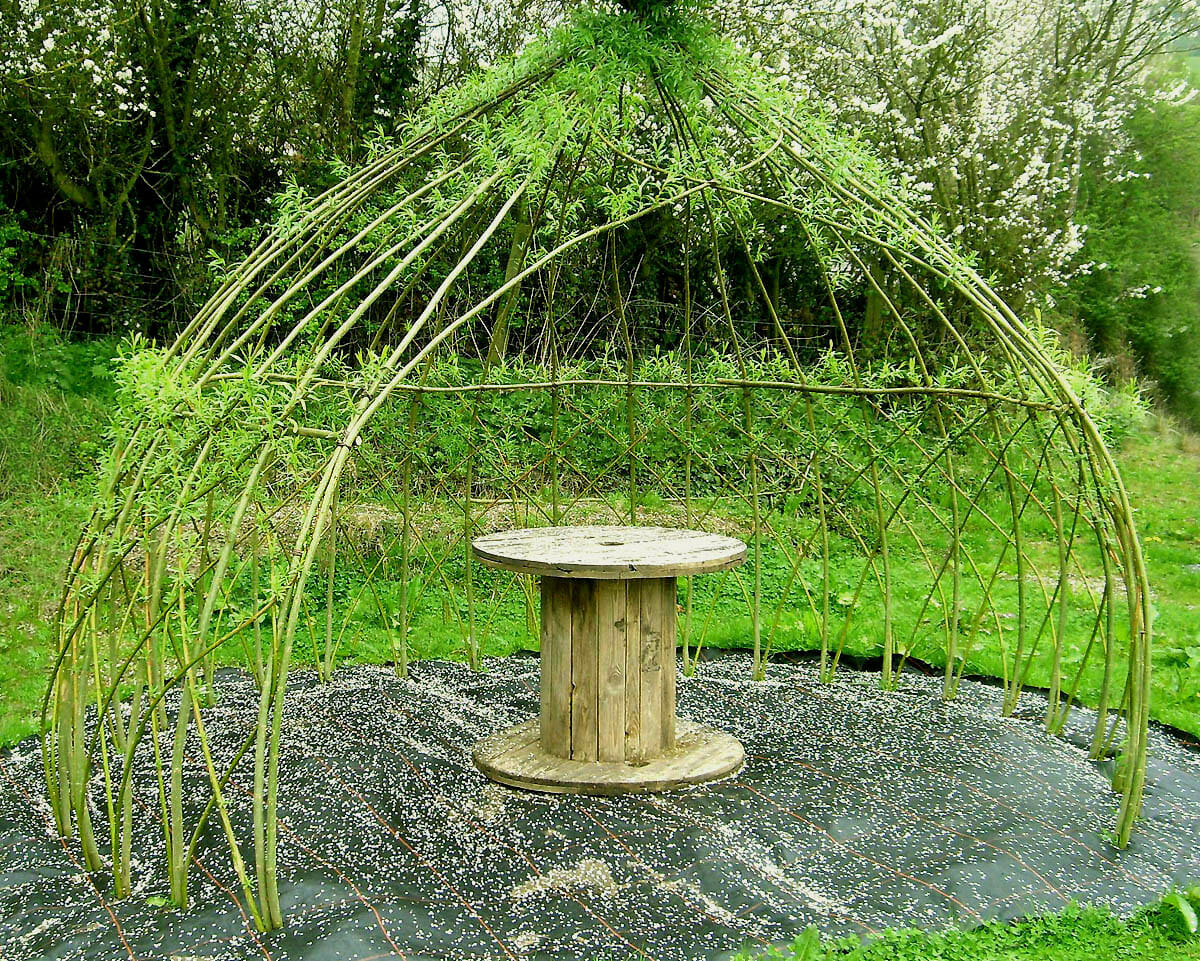Willows can be woven into more than just baskets - here's how to plant your own gazebo for hot weather lounging.

Willow trees have an unusual trait: freshly cut branches will sprout roots and grow into new trees when merely plunked into the ground and watered. By taking cuttings from an established willow tree, “planting” them strategically and weaving the supple young branches together as they grow, any number of structures – such as a gazebo, pergola, play hut, party dome, sweat lodge, art cave or even a shady area for your livestock – can be created on your land.
Though it’s possible to build an elaborate willow palace, this is, in its essence, a simple DIY project with plenty of potential for creative interpretation. There are a few basic steps needed for any type of willow structure and a few things to keep in mind so you end up with something that’s functional and aesthetically graceful. It will take a few years for a willow structure to mature into its envisioned form, so the best time to plant one is now. Anytime in spring, summer or fall is a fine time to start the process.
[mf_h6 align=”left” transform=”uppercase”]Step 1 – Make Cuttings[/mf_h6]
Finding a willow to take cuttings from may take a bit of sleuthing, but the trees grow wild almost everywhere (except deserts and tropical places) and are often planted in parks and yards, so chances are there is a willow near you. Any type of willow tree can be used (click here for help identifying them). Make sure you have permission before cutting, but don’t worry about harming the tree – it will sprout back with vigor.
Any size cutting will work, but it’s best if all the cuttings are roughly the same size so they grow in evenly. Straight, pliable sections of branches are best; avoid older branches with thick bark. The larger the cutting, the more quickly it will grow into a usable structure. Four to six feet in length is ideal, though you will have to gauge how many cuttings of a consistent size you can get from the willow tree(s) that are available to you. One cutting per foot of wall space is a general rule of thumb to follow.
Strip the leaves from the cuttings and cut off any side branches. If the cuttings will not be planted immediately, store them in a bucket of water to keep them from drying out. They may be kept in this way for several months if needed – willows are water-loving trees and will begin to sprout while sitting in water, which only speeds up the process after they’re put in the ground. Throughout the process, it’s important to keep the cuttings oriented in the same way that they were on the tree. When planted, the ‘direction of growth’ needs to be pointed up.
[mf_h6 align=”left” transform=”uppercase”]Step 2 – Plant According to a Design[/mf_h6]
Here’s where creativity comes into play. Do you want a dome shape, a globe shape, a long tunnel, a square or a hexagon? The possibilities for design are numerous. It’s important to have a vision in mind when you put the cuttings in the ground. You may want to angle them laterally in a criss-cross pattern or angle them toward a central point so they grow into a pyramid. If you space the cuttings tightly together, you’ll end up with a dense wall of foliage once they start growing. If you’re more interested in a shady canopy, space them farther apart for of an open air, pavilion-like structure. Always leave at least one gap for an entrance.
Pick an area that will get at least six hours of sunlight every day. Loose, rich soil helps them grow faster (adding compost never hurts), but willows will grow in very poor soil as long as they have lots of water. If the willow cuttings are stout enough and the ground is soft enough, it’s possible to carve one end of the cutting into a point and push it into the ground or even to pound it with a sledgehammer. If needed, use post hole diggers to make planting holes. To encourage abundant rooting, cut scar marks into the bark on the portion of the cutting that will be underground. Bury them about one-quarter of their length.
After planting, irrigate religiously to promote fast, lush growth. There is no such thing as overwatering willow trees; until they are well-established, the best rule of thumb is to water whenever the surface of the soil dries out.
[mf_h6 align=”left” transform=”uppercase”]Step 3 – Prune, Train and Maintain
[/mf_h6]
The willow cuttings should start growing within a week or two. Immediately prune out any branches that sprout in a direction that does not conform to the desired shape. This will force the sapling to put all of its energy into the branches that do grow in the right direction.
The training process begins at the end of the first growing season, when the willows are dormant. This is the time to weave the supple new branches together or tie them to each other to start creating the structure you’ve imagined. Use stretchy plastic gardening tape if you’ll be tying them together. Each year, repeat the process of removing unwanted branches and weaving new growth into the desired form. Remember to keep watering to keep the willows alive and healthy.
If you need guidance along the way, consult one of the many books on willow structures. If you live in the UK, you can order a DIY kit from www.thewillowbank.com.
Over time the supple young branches will harden into the shape in which they’ve been trained and you’ll discover another astonishing trait of willow trees: wherever two branches touch each other, they will eventually fuse into a solid, living piece of architecture.
Very helpful. Thanks.